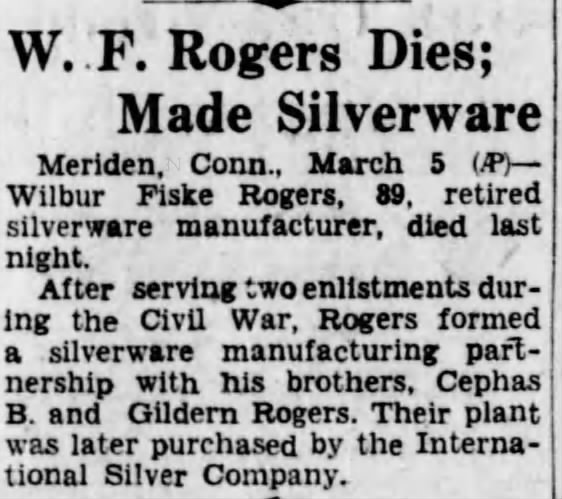Navigation
Install the app
How to install the app on iOS
Follow along with the video below to see how to install our site as a web app on your home screen.
Note: This feature may not be available in some browsers.
More options
You are using an out of date browser. It may not display this or other websites correctly.
You should upgrade or use an alternative browser.
You should upgrade or use an alternative browser.
wf.rogers mfg co special
- Thread starter IHC656
- Start date
devldog
Silver Member
- Mar 9, 2012
- 3,663
- 6,385
- Detector(s) used
- Whites MXT ALL PRO, Minelab Safari
- Primary Interest:
- Relic Hunting
Nice looking Saves there. The cap piece, I'm wondering if it could have been a plug or stopper for a canteen. A cork would have been attached to the stem piece and inserted into the neck of the canteen. The loop on top of the cap, would have had a small chain or a piece of leather attached to the loop and the other end attached to the side of the canteen to prevent the topper from being lost. Just a thought.
IHC656
Full Member
- Thread starter
- #3
Interesting theory.Nice looking Saves there. The cap piece, I'm wondering if it could have been a plug or stopper for a canteen. A cork would have been attached to the stem piece and inserted into the neck of the canteen. The loop on top of the cap, would have had a small chain or a piece of leather attached to the loop and the other end attached to the side of the canteen to prevent the topper from being lost. Just a thought.
Thanks
Red-Coat
Gold Member
The multitude of variations on ‘Rogers’ marks have various dates arising from members of the family (and those not directly related) operating solo and in partnerships that were continually created and dissolved, which are not well-documented. Some of the ‘plain’ patterns are also not well-documented.
W.F. Rogers was active in Meriden Connecticut during the late 1800s to early 1900s and, for flatware with that specific ‘W.F. Rogers Mfg. Co.’ mark where patterns can be dated, they range between c.1884-c.1901.
W.F. Rogers was active in Meriden Connecticut during the late 1800s to early 1900s and, for flatware with that specific ‘W.F. Rogers Mfg. Co.’ mark where patterns can be dated, they range between c.1884-c.1901.
IHC656
Full Member
- Thread starter
- #5
ThanksThe multitude of variations on ‘Rogers’ marks have various dates arising from members of the family (and those not directly related) operating solo and in partnerships that were continually created and dissolved, which are not well-documented. Some of the ‘plain’ patterns are also not well-documented.
W.F. Rogers was active in Meriden Connecticut during the late 1800s to early 1900s and, for flatware with that specific ‘W.F. Rogers Mfg. Co.’ mark where patterns can be dated, they range between c.1884-c.1901.
- Oct 26, 2004
- 24,717
- 24,641
- 🏆 Honorable Mentions:
- 2
- Detector(s) used
- Minelab Explorer
- Primary Interest:
- Shipwrecks


Obituary for W. F. Rogers
Clipping found in The Brooklyn Daily Eagle published in Brooklyn, New York on 3/5/1932. Obituary for W. F. Rogers
Nice!!! Congrats!!!Tried searching the over grown brush covered homesite and didn’t find much.
This fork that I have not been able to date. And what appears to have been some sort of cover/cap.
Top Member Reactions
-
 3488
3488 -
 2073
2073 -
 1984
1984 -
 1141
1141 -
 1139
1139 -
 923
923 -
 840
840 -
 811
811 -
 806
806 -
 783
783 -
 754
754 -
 535
535 -
 499
499 -
 464
464 -
 446
446 -
 422
422 -
 416
416 -
E
413
-
 412
412 -
 405
405
Users who are viewing this thread
Total: 2 (members: 0, guests: 2)








